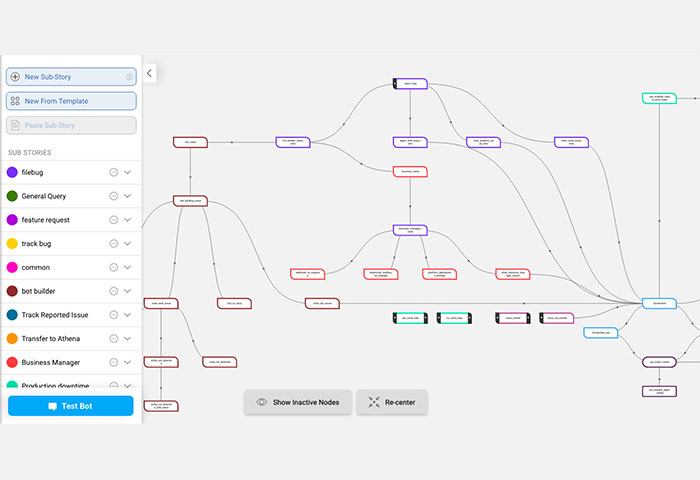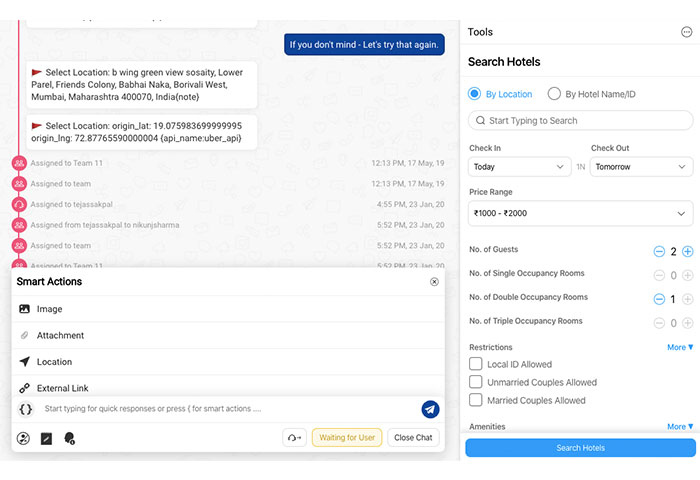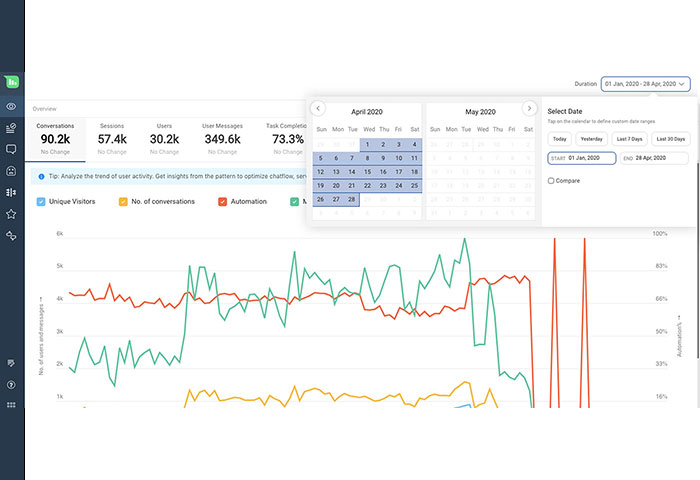Conversational AI: Automate
and Elevate your Customer
Interactions
The last decade or so has seen a paradigm shift from clicks to conversations in the way we interact with friends, family, and even businesses. From messaging apps like Facebook Messenger, WhatsApp, and Google Business Messages to voice assistants, people now increasingly use conversational interfaces not only to communicate but also to get work done.
Businesses, from SMBs to large enterprises, can benefit significantly from leveraging a Conversational AI platform. It is against this backdrop that Conversational AI has emerged as a powerful tool for brands to engage and serve their customers.
What is Conversational AI?
‘Conversational AI’ refers to technologies that automate communication and create personalized customer experiences at scale. A Conversational AI solution includes an interface such as a messaging app, chatbot, or an AI voice agent which customers can interact with using natural language.
Businesses can use Conversational AI platforms to automate a wide range of customer-facing touchpoints – including their website, app, social media platforms such as Facebook and Twitter, messaging platforms such as WhatsApp, or voice assistants such as Google Home or Amazon Alexa.
While 'chatbot' is frequently used to refer to Conversational AI solutions, the term tends to have a limited ‘text-only’ connotation. Conversational AI is a broader term that is more inclusive of conversational solutions, across text and voice.
Learn More: Understanding Conversational AI – What, Where & How You Can Use Chatbots
The Evolution of Conversational AI
The earliest chatbots were simply programmed with scripted responses based on a limited number of predefined user inputs (in the form of specific keywords and phrases). These chatbots lacked the ability to learn and were unable to retain context between sessions. They were typically used to automate very basic tasks, such as responding to FAQs.
The advent of Natural Language Understanding (NLU) and Machine Learning (ML) proved to be the turning point in the evolution of the technology.
NLU is what allows Conversational AI to understand a user, regardless of the user’s choice of words. This enables the user to chat with the AI much as they would with a human agent, without being confined to specific keywords and phrases.
ML, on the other hand, allows the AI to train itself on the basis of conversational data. With every customer interaction, the AI becomes more adept at interacting with customers and catering to their needs.
It is owing to NLU and ML that conversational interfaces have evolved from mere ‘chatbots’ to ‘Intelligent Virtual Assistants’ – sophisticated, interactive and truly ‘intelligent’ interfaces that are not bound by a ‘company script’ but have the ability to truly put your customers’ needs first.
Interested in learning more about the evolution of Conversational AI?
How Conversational AI Helps Brands and Customers
Delivering exceptional customer experience is the key to lasting success for any brand. But the on-ground realities often do not live up to this age-old wisdom. Many businesses continue to be plagued by the same customer experience issues, which in turn adversely impacts their brand.
To begin with, it often takes simply too long for customers to get hold of a customer care representative on the phone or through email. This is a very frustrating experience for a customer, particularly one who requires instant assistance. To make matters worse, even when a support agent does come online, they are unable to dedicate much time and attention to solving a customer’s problem. In some cases, they may even lack the knowledge and competence to do so.
These problems stem from the conventional customer support model, which is heavily dependent on contact centers staffed by human agents. These support agents can only help a limited number of customers in a day, and spend a large part of their time resolving the same routine, repetitive queries. This leaves them unable to dedicate time and attention to helping customers facing more complex issues.
Implementing a Conversational AI solution solves these problems for brands:
-
Conversational AI automates the end-to-end resolution of routine queries and FAQ’s, which tend to account for 80% or more of total inbound query volume. This enables support agents to dedicate their attention to the remaining 20% of complex queries, allowing them to give personalized attention to customers who really need their direct assistance.
-
An AI Assistant, unlike a human agent, is not bound by ‘office’ hours and is available 24/7, allowing customers access to support anytime, from the comfort of their smartphone screens. Conversational AI also eliminates the scope for human error or incompetence in customer interactions, and ensures a consistent experience.
-
Customers are already very comfortable using conversational interfaces to communicate and to get things done – be it through messaging apps or voice-based assistants like Google Home, Alexa and Siri. Therefore, the seamless interface offered by a Conversational AI solution is likely to appeal to them, for its interactivity, ease-of-use and swiftness of service – contributing to a significantly improved customer experience.
-
Conversational AI offers a vastly improved online shopping experience to customers – combining the convenience of an e-commerce platform with the personalized service they would receive at a physical store. An AI-powered virtual sales assistant simulates the experience of interacting with a helpful in-store sales clerk – understanding a customer’s requirements, answering their queries, and making relevant recommendations.
Learn More: 3 Reasons Why Conversational AI Has Been Embraced By Customers
In addition to enhancing customer experience, Conversational AI can help a brand slash 90% of its support costs – with a single AI Assistant being able to handle the same volume of queries in a month that would require 600 human agents. A business can massively scale up their customer support capacity to deal with increased query volumes in virtually no time, and with no additional expense, if they have implemented a Conversational AI solution.
Learn More: How Conversational AI Helps You Ensure Business Continuity During Crisis
Conversational AI Use Cases
Businesses across verticals have successfully implemented Conversational AI solutions. Take a deep-dive into the key Conversational AI use cases for each sector with the resources given below.
E-Commerce & Retail
Conversational AI enables you to drive sales by bringing the experience of interacting with an in-store sales clerk to the virtual world – understanding customer requirements, offering personalized recommendations and strengthening purchase intent . An AI Assistant can enhance post-purchase experience for customers by answering FAQs, and resolving user queries around refunds & cancellations, order tracking, payment etc.
5 Reasons Top E-commerce Businesses Have Made Chat Their Primary Customer Service Medium. From improving user experience, to scaling up support, learn why leading online retailers have increasingly turned to Conversational AI to serve their customers.
4 Ways Conversational AI is Transforming Retail. Immersion, speed, convenience and automation are the pillars of the tech-driven retail revolution. Learn how Conversational AI helps retailers with this.
Conversational AI enables you to automate the entire customer journey from acquisition to support. An AI Assistant can understand your customer’s financial requirements and make personalized recommendations based on their profiling, driving account registrations. You can boost the efficiency of your customer support, by using the AI Assistant to answer FAQs, offer account information, and resolve service requests in real-time.
4 Chatbot Solutions For The Financial Services Industry. From scaling up support, to driving sales through intelligent lead generation, learn about some of the Conversational AI solutions that have been implemented by Financial Services brands.
Chatbots in Banking – Examples, Best Use Cases and the Future. Banks have always been early adopters of new technology. Learn about some of the innovative Conversational AI solutions implemented by banks across the globe.
Conversational AI can enhance customer experience by serving as a virtual travel agent for your customers, interacting with and advising customers on their preferred communication channel, be it Website, Messenger or WhatsApp. With an AI Assistant you can offer real-time post-purchase support and resolve queries around booking issues, itinerary changes, local attractions, web check-ins, refunds & cancellations, and more.
4 Ways Chatbots Are Transforming the Travel Industry. Learn why travel & hospitality brands have increasingly turned to Conversational AI to engage and serve their customers.
Digital Media
Conversational AI allows you to triple user engagement and boost retention through personalized content recommendations based on customer intent and previous data. With intelligent prompts and relevant updates, nurture users with relevant content throughout the buyer journey. An AI Assistant enables you to offer 24/7 support, answering queries around subscriptions details, payment issues etc.
4 Use Cases for Conversational AI in the Media & Entertainment Industry. From customer service, to content discovery, learn how digital media brands have leveraged Conversational AI as a powerful customer engagement tool.
Healthcare
Conversational AI can be leveraged to effectively disseminate accurate and timely information about healthcare issues through an engaging interactive interface, as well as answer queries around these issues in real-time. Hospitals, clinics and other medical facilities can use AI Assistants to automate the response to frequently asked patient queries such as appointment bookings, report status etc.
Conversational AI in Healthcare: 2 Key Use Cases. Learn about two of the major ways healthcare providers can leverage Conversational AI – information dissemination and customer care – with case studies for each.
Haptik’s Conversational AI Solutions
Haptik has successfully implemented AI chatbot solutions for enterprises across verticals such as Retail, Financial Services, Travel & Hospitality, and Telecom. We offer the following four types of solutions:
80% of inbound customer queries are routine queries or FAQs. Our customer support solution resolves these queries end-to-end, while facilitating seamless smart-routing of complex queries to human agents.
AI Improves Customer Support
Use WhatsApp, Facebook, Google Business Messages, and SMS chatbots to engage customers instantly on the world’s largest messaging platforms. Resolve customer queries 9X faster and deflect traffic from expensive support channels.
WhatsApp AI Chatbot Automation
Our Lead Generation solution serves as a 24/7 virtual sales assistant - answering FAQs and using intelligent prompts to convert passive website visitors into interested customers.
AI Conversations Create Leads
Our voice-enabled recommendation engine brings the experience of interacting with a helpful in-store sales clerk to the virtual world, driving sales across digital touchpoints.
AI Recommendation Engines
Drive Increased Sales
Each of these Conversational AI solutions drives ROI by either reducing customer care costs or driving sales.
You can learn more about our platform here.
A simple but powerful tool to build, train and deploy IVAs. The Conversation Studio provides a framework, and components, that enables you to build your own conversational flows with minimal effort. In fact, using pre-defined templates, it is possible to develop an IVA in as little as 4 hours using this tool.
The Conversation Studio operates on a node-based graph model and enables the creation of interconnected conversational flows. It also allows the integration of dynamic API’s to enable your IVA to tackle complex use cases. You can test your IVA and check for bugs and other issues in the conversational flow. Once the IVA is live, you can continue to use the tool to iterate and improve the solution on the basis of real data.

A dashboard which enables human agents to monitor conversations between the IVA and customers, and take over the conversation when necessary. It enables seamless auto-routing of conversations involving complex customer issues to human agents – using our proprietary chat assignment logic that is based on agent expertise and traffic.
The dashboard includes tools to help support agents in their resolution of customer queries, such as the ability to fetch user information from the CRM system and ‘Smart Actions’ (including sharing images, attachments, location etc.) It also facilitates monitoring of agent performance and efficiency, including metrics such as First response time and Resolution time
LEARN MORE: Live Chat Agent: Bringing a Human Touch to Conversational AI

Provides access to real-time conversational analytics, enabling us to drive customer success by measuring and improving the effectiveness of our IVA solutions. The dashboard can be used for real-time review and resolution of issues, including automation failures and customer drop-offs.
It offers a deep-dive into conversations on the IVA, enabling granular analysis of the entire conversation, individual user messages, and even words used. By analyzing node traffic, it provides a detailed insight into how customers move through the conversational flow. The dashboard also provides a CSAT feedback score for all conversations.

The ‘brains’ behind the Conversational AI. Our NLU (Natural Language Understanding ) model has been developed using 3 billion+ consumer data points. It has been from the ground-up separately for Commerce and Customer Care – the two key business functions that Haptik caters to. The NLU Engine replicates the first principles of human behavior through algorithms while performing tasks.
Our Commerce Engine is equipped with industry-specific Domain Knowledge & Information Extraction, can carry out Sentiment Analysis of User Reviews, and make personalized product recommendations. Our Care Engine is equipped with advanced Intent Detection and Named Entity Recognition capabilities, as well as Disambiguation logic, to accurately pinpoint user intent. Both Engines include a Context Manager, to retain the overall context of the conversation, as well as specific user information collected during the conversation.
LEARN MORE: How Does a Chatbot Learn on Its Own?
In keeping with the principle of “Build Once, Deploy Anywhere”, Haptik’s IVA solutions are omnichannel, and can be used by brands to engage customers across a wide range of platforms. Our solutions are also CRM agnostic and can be seamlessly integrated into any Customer Relationship Management system.
What does it take to build a Conversational AI solution end-to-end?
Read our whitepaper to find out!
Shape the New Era of Customer Service with Generative AI
Products
Solutions
Industries
Knowledge




Copyright © Jio Haptik Technologies Limited 2026 | Data Security & Privacy Policy | GDPR Ready | CCPA Ready| Terms
Asia Pacific | EMEA | North America | enterprise@haptik.ai
